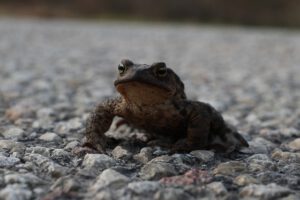Do Frogs Migrate? (7 Facts You Should Know)
Frogs don’t always stay in our ponds and lakes like most of us expect. They are commonly spotted moving in mass at certain times of the year. This might make you wonder if these little creatures migrate, and if so, why do they migrate to.
So, do frogs migrate?
Yes, frogs do migrate. They often move during spring, leaving their hibernation sites to water bodies, where both sexes congregate to breed.
Sometimes, after breeding, the frogs will migrate to feeding sites and remain there for the rest of spring and summer. They eventually make their way back to sheltered locations or hibernation spots during winter.
We have researched some interesting facts about frog migration you probably didn’t know about.

What is Frog Migration?
Frog migration simply means the movement of frogs from one habitat or location to another. In most cases, the frogs will return back to their previous location or habitat.
Like many other amphibians, frog migration is typically from upland to lowland wetland or breeding locations. Sometimes, this is done to fulfill part of their life cycle, and sometimes, it is done to survive the cold season.
A lot of frogs usually come out when it rains, and this is when they often migrate. During this time, the water bodies get filled due to the rainwater, which creates a more convenient habitat for the incoming frogs. The rain also helps the frogs to stay wet while making their journey.
Frog migration is highly contingent on the weather condition. So the exact time may vary in different locations. That said, most frogs favor wet evenings as the time to move.
Why do Frogs Migrate?
Frogs commonly migrate to breed (in the case of adult frogs) or to leave their watery habitats to damp areas on land (in the case of tiny frogs). That said, there have been records of frogs traveling long distances for reasons besides breeding.
To gain a better understanding of frog migration, it will help to understand their life cycle.
Frogs are usually born in water, where they exist as frogspawn or eggs. In the case of a toad, it is called a toad spawn. The frogspawn eventually grows and transforms into a tadpole. At this point, it starts learning how to swim.
In the next stage of development, the tadpole metamorphoses or transforms again into a tiny frog. At this point, the frogs start leaving the water bodies to new habitats, usually drylands (grassy areas and woodlands). Some adult frogs also live in trees or underground.
As the frogs grow to maturity, they make their way back to the water bodies, where they congregate to breed and lay their own eggs.
This is the typical life cycle of a frog. Let’s look at each phase more closely.
Frog Migration from Their Birthplace or Pond
As earlier indicated, when tadpoles metamorphose into tiny frogs or froglets, they begin to emerge from the pond or water in search of a new home. The exact time this occurs largely depends on the time the frogspawn was laid. But in most cases, it is during summer (usually around June till Sept.).
During this period, it is not uncommon to see a lot of tiny frogs moving en masse (usually in hundreds). Depending on your location, you may see them around your garden or in the village.
After dispersing to their new home, they often remain there till they are mature enough to mate and lay their own spawns. Some of the places you might find the frogs during this time include wet woodlands, treetops, underground, near ponds, shady spots, and other damp locations on land.
Migration from the pond can take a few days or might stretch to weeks. But it usually takes 2-3 years before the frogs are old enough to return to their breeding sites or birthplace.
This whole process is completely natural. Unfortunately, only a tiny portion of the baby frogs survive through to adulthood. Some get trapped or killed during migration, while others are attacked by predators in their new environment.
During this time, make sure you inspect your lawn before mowing.
It is best not to cut or mow your lawn or garden at this time, as there might be frogs hiding there. But if you must, then inspect the grass first to ensure there’s no trace of any amphibian.
We all have an important role to play in ensuring the frogs reach their destination safely!
Frog Migration to Breeding Sites
As spring appears, frogs start their mass exodus to the water bodies to breed. In some places, this usually starts during mild March evenings as the weather gets warmer.
You may see a lot of common frogs in your garden ponds during this period. But more commonly, most of them will be found in shady ponds in an area with many reeds.
The male frogs usually get to the ponds first, and then wait for the females to arrive. Sometimes, they may wait outside the pond and then piggyback or cling unto the females as they pass. Spawning occurs afterward.
This whole process is completely natural doesn’t only occur among frogs but also other amphibians, especially toads.
As indicated earlier, migration highly depends on the local weather in the area. Sometimes, it can be as early as January when the frogs emerge from their hibernation sites.
As earlier indicated, shady ponds are usually the preferred spot for spawning is a shady pond, but some frogs may also use puddles.
Moving to Hibernation Site
Not all frog species hibernate to survive the cold winter season. But those that do often have to migrate from their breeding ponds to the hibernation sites.
The hibernation sites are commonly deep lakes, but also include mud and soil.
The frogs overwinter in the lakes and remain there till summer.
During frog migration in fall and spring, it is not uncommon to see a large number of frogs crossing the highways or busy roads. This can be very dangerous. In fact, most of the frogs often get killed by speeding vehicles.
Where do frogs migrate to
Frogs commonly migrate to breeding sites, either from hibernation sites or their upland homes.
In the same way, froglets also leave their aquatic homes to settle in new habitats on land.
It is with noting that not all frogs return to the same pond or aquatic home where they hatched. They might migrate to a completely different location to breed.
How Far do Frogs Migrate?
So how far do frogs migrate? It all depends on the location of the breeding site and the conditions in their new homes.
Most froglets will cover long distances until they find a suitable habitat on land (ideally near a damp location). In the same way, the adult frogs may travel long or short distances to breed, and may not return to the same site where they metamorphosed.
For example, the migration of the leopard frog can stretch over 2 miles from wetland to hibernation sites. Most common frogs cover over 500 meters or more when they leave the pond to head back to their homes on land.
When dispersing from their watery homes, frogs commonly move as a group in order to be safe from predators. It’s still not clear how they can all move at the same time, but it’s fascinating that they do.
This lends even more weight to the fact that frogs are more instinctive creatures.
Do Frogs Migrate Back To Their Birthplace?
Yes, some frog species usually migrate to their birthplace.
Studies show that they are able to do this using their olfactory perception. In other words, they can master the route they take using their sense of smell.
Consequently, when they become matured and are ready to breed, they have to rely on the same sense of smell to return to their ancestral home. This is accomplished using various olfactory signals in the local environment to identify the route they once traveled and keep to it.
That said, some frogs don’t usually return to their birthplace or wetland to breed. They may choose to move to a different location that is more conducive or closer to their existing habitat.
Problems Associated with Frog Migration
Despite moving en masse (often in thousands), frogs often encounter problems along the way while migrating to a new environment. Below, we examine the two major ones.
- Disruption of Travel Route
Highway mortality caused by traffic is the number one problem associated with frog migration.
Most frogs keep to the same route when migrating each year. This puts them at risk of getting killed if a road or highway is built over that route. The frogs can easily get squashed by speeding vehicles.
Sadly, many wood frogs are killed this way almost every year.
Sometimes, due to their color, the frogs may appear as leaves on the road making them less noticeable. So try to be more observant when cycling or driving over highways, especially during fall and spring.
In some cases, instead of a road, it may be a building or fence that is dividing the migration routes. As a result, some of the frogs end up getting trapped along the way.
- Displacement by Humans
Frogs can also be displaced from their ancestral homes, which may result in the appearance of diseases or invasive plants. This happens when you remove the frogs or spawns from their original pond to a different one that may not be suitable for them.
Furthermore, getting rid of the old pond also puts the returning frogs in danger of getting killed as they try to locate a new breeding site. Sometimes, the conditions in the new environment may not be as convenient as the old one, which causes the frogs to suffer as a result.
Conclusion: Do Frogs Migrate?
So, coming back to the original question – do frogs migrate? Yes, frogs migrate. As described above, they commonly do this for breeding purposes, to move to a new home, or seek shelter for winter (hibernation).
If you ever come across an exodus of frogs during summer or spring, whether on the road or in your garden, try not to get in their way.
Also, if you have any pond around, try not to relocate the spawns or frogs in it to another pond to avoid diseases or migration problems. Let me know if you have any more questions or suggestions about frog migration. Use the comment section.
Meanwhile, if you have more time, here are other great topics you might want to check out:






